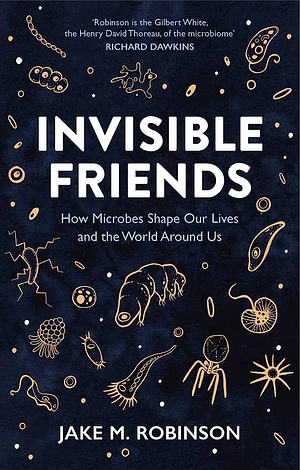
Invisible Friends: How Microbes Shape Our Lives and the World Around Us
by Jake M. Robinson
Genres: Non-fiction, SciencePages: 304
Rating:

Synopsis:As we continue to live through a pandemic, all eyes are on microbes: an imperceptible and pervasive threat that hangs heavy on the air and clings to surfaces. But the reality of micro-organisms is far more diverse and life-sustaining than such a notion would have us believe (hence the title of this book). Not only are they omnipresent, but we are highly attuned to their workings - both in the world at large and right here within our own bodies. Meanwhile, cutting-edge microbiome research is changing our understanding of reality, challenging fundamental concepts of free will and individuality. Threaded through everything are microbes: the very glue that holds ecosystems together.
This topical, engaging and original book counters the prevailing narrative of microbes as the bane of society, along the way providing much-needed clarity on the overwhelmingly beneficial role they play. We discover how the microbiome is highly relevant to environmental and social equity issues, while there's also discussion about how microbes may influence our decisions: even the way we think about how we think may need to be revisited. Invisible Friends introduces the reader to a vast, pullulating cohort of minute life - friends you never knew you had.
Jake M. Robinson’s Invisible Friends is a fairly basic discussion of microbes and what they do — how they don’t just make us sick, but also influence how we feel through their influence on our guts, immune systems and more. It really is very, very basic though, touching only lightly on important topics like antibiotic resistance, and extremely lightly on what we might do about that, barely giving half a page to the potential of bacteriophages. Which is a shame, because we need to move toward using methods like bacteriophages, and for that people need to know more about them and not be afraid of them. (Check out Tom Ireland’s The Good Virus, to that end.)
I know that I’m not exactly the target audience for this book, given my background knowledge and interests even before I started doing an MSc in this stuff, but it still felt excessively simplistic. Really, it seemed like a vehicle for Robinson to tell people to spend more time outside and stop being so germophobic.
It’s true that that’d be good for us, and he’s not wrong about the impact of city living on the human microbiome, nor about the potential benefits of trying to fix that. It’s just that sometimes it begins to feel like he’s self-aggrandising, discussing this project or that that he’s been involved with that aims to improve this or that in order to, you’ve guessed it, improve people’s exposure to microbes in the city environment. We also hear repeatedly about the fact that he’s writing the thing outside in a forest. He does at least touch on the fact that there is some serious inequality in ability to access natural landscapes, at least on an economic level, which is good. (He doesn’t discuss accessibility issues of other kinds other than location and money, though.)
Anyway, I know I’m a harsh judge of this kind of thing, but I’m perfectly capable of enjoying a good book aimed at laypeople for being clear and precise in communication, even when it’s the basics — like Philipp Dettmer’s Immune — so I don’t think it’s just that.
Rating: 2/5
